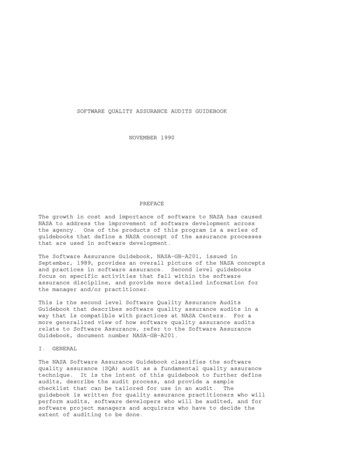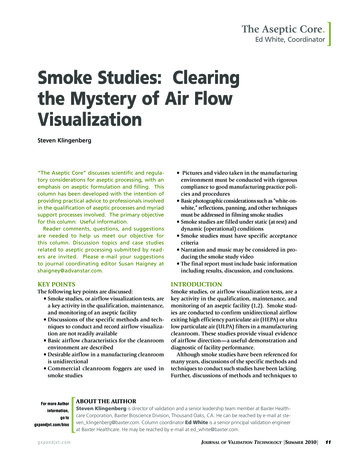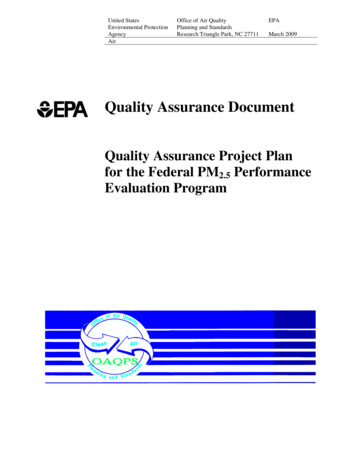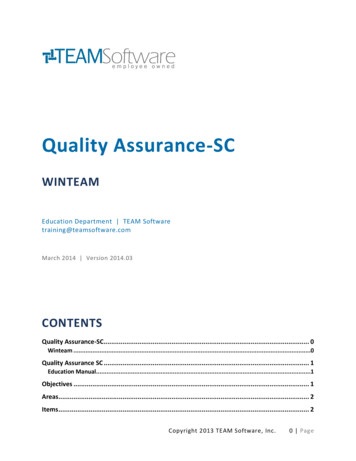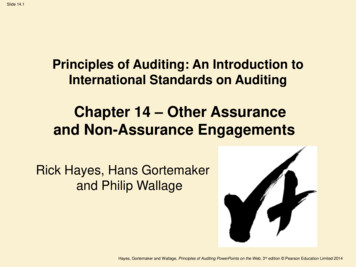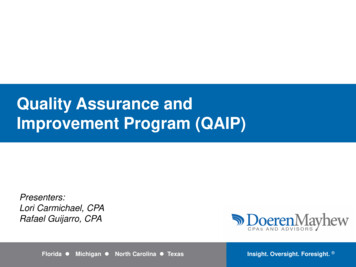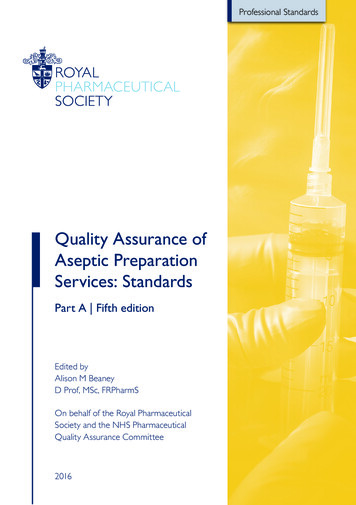
Transcription
Professional StandardsQuality Assurance ofAseptic PreparationServices: StandardsPart A Fifth editionEdited byAlison M BeaneyD Prof, MSc, FRPharmSOn behalf of the Royal PharmaceuticalSociety and the NHS PharmaceuticalQuality Assurance Committee2016
Quality Assurance of Aseptic Preparation Services: StandardsFifth editionEdited byAlison M BeaneyD Prof, MSc, FRPharmSRegional Quality Assurance Specialist North East and North CumbriaChair NHS Pharmaceutical Quality Assurance CommitteeVisiting Professor, University of Sunderland.On behalf of the Royal Pharmaceutical Society and the NHS Pharmaceutical QualityAssurance Committee Royal Pharmaceutical Society 2016First edition published 1993 by the Quality Control Sub-Committee of theRegional Pharmaceutical Officers CommitteeSecond edition published 1995 by the NHS QC CommitteeThird edition published 2001 by the Pharmaceutical PressFourth edition published 2006 by the Pharmaceutical PressFifth edition published 2016All rights reserved. No part of this publication may be reproduced, stored in a retrievalsystem, or transmitted in any form or by any means, without the prior written permissionof the copyright holder.The right of Alison M Beaney to be identified as the editor of this work has been asserted byher in accordance with the Copyright, Designs and Patents Act, 1988.DISCLAIMERThis publication is intended as professional standards and may not include all informationrelevant to the subject matter. You should interpret all information and advice in light of yourown professional knowledge and all relevant literature and guidelines. Nothing in this publicationconstitutes legal advice and cannot be relied upon as such. Whilst care has been taken toensure the accuracy of content the Royal Pharmaceutical Society excludes to the fullest extentpermissible by law any liability whether in contract, tort or otherwise arising from your relianceon these standards, information and advice.
CONTENTSCONTENTS (PART A – STANDARDS)PREFACE3CHAPTER 1INTRODUCTION4CHAPTER 2DEFINITIONS / GLOSSARY OF TERMS7CHAPTER 3MINIMISING RISK WITH INJECTABLE MEDICINES18CHAPTER 4PRESCRIBING, CLINICAL PHARMACY AND ASEPTICSERVICES VERIFICATION24CHAPTER 5MANAGEMENT32CHAPTER 6FORMULATION, STABILITY AND SHELF LIFE37CHAPTER 7FACILITIES AND EQUIPMENT44CHAPTER 8PHARMACEUTICAL QUALITY SYSTEM58CHAPTER 9PERSONNEL, TRAINING AND COMPETENCY ASSESSMENT68CHAPTER 10 ASEPTIC PROCESSING73CHAPTER 11 MONITORING80CHAPTER 12 CLEANING, SANITISATION AND BIODECONTAMINATION97CHAPTER 13 STARTING MATERIALS, COMPONENTS AND CONSUMABLES110CHAPTER 14 PRODUCT APPROVAL114CHAPTER 15 STORAGE AND DISTRIBUTION117CHAPTER 16 INTERNAL AND EXTERNAL AUDIT122Acknowledgements, news and updates. Available at: www.rpharms.com/qaapsIn 2016 additional supporting resources to aid implementation of the standardswill be developed into a handbook. The handbook will provide part A –standards and part B – support resources. Further news and updates on access topart B and its planned launch as part of “Quality Assurance Aseptic PreparationServices: Standards Handbook” is available at: www.rpharms.com/qaaps2QUALITY ASSURANCE OF ASEPTIC PREPARATION SERVICES: STANDARDS PART A
PREFACEPREFACEThese standards for the qualityassurance of aseptic preparation servicesare a joint initiative between the RoyalPharmaceutical Society and the NHSPharmaceutical Quality AssuranceCommittee. We share an aim todevelop national standards that supportbest practice and the care of patients.Pharmacy aseptic preparation servicesare supporting the care of some of themost critically ill patients.All the standards have been revisedand updated for this fifth edition.The standards are well established andwidely used by UK hospital pharmacydepartments. Their origin goes backprior to 1993, when the first edition ofQuality Assurance of Aseptic PreparationServices was published by the NHSQuality Control Sub-Committee.The relationship between the RoyalPharmaceutical Society and the NHSPharmaceutical Quality AssuranceCommittee extends over manyyears and our publishing division, thePharmaceutical Press (RPS Publishing),has previously published the third andfourth editions of Quality Assurance ofAseptic Preparation Services.Since 2010 the Royal PharmaceuticalSociety has become a body akin to aRoyal College. As such, it is appropriatefor us to produce and host thesestandards as part of our library ofprofessional standards. The standardshave particular relevance to the RPSleadership roles, including our vision forthe pharmacy workforce (RPS 2015).I would like to join the editor, Dr AlisonM Beaney, in thanking the contributors.These standards are a result of the hardwork and dedication of many expertsfrom across the UK.In the UK these nationally agreed qualitystandards and an audit programmeare in place to assure the quality ofpharmacy aseptic units (unlicensed)within the NHS. The standards areprimarily intended for use within theNHS but they will also be of use tostudents, licensed units, individuals andorganisations in other countries as wellas the UK.Ash Soni OBE FFRPS FRPharmSPresident Royal Pharmaceutical SocietyReferencesRoyal Pharmaceutical Society (RPS) (2015). Transforming the Pharmacy Workforce in Great Britain: The RPS Vision.London: Royal Pharmaceutical Society. Available at: ngthe-pharmacy-workforce-in-gb.asp (accessed 12 February 2016).Royal Pharmaceutical Society (RPS). Quality Assurance of Aseptic Preparation Services (news). www.rpharms.com/qaaps3QUALITY ASSURANCE OF ASEPTIC PREPARATION SERVICES: STANDARDS PART A
CHAPTER 1 INTRODUCTIONCHAPTER 1 INTRODUCTIONAseptic preparation of medicines is animportant part of the service provisionby pharmacy departments to facilitateaccurate and timely administrationof injectable medicines for patients.It is a complex and demanding activityrequiring skilled staff, appropriatefacilities and close monitoringand control. Standards to guide and monitor the safeand accurate delivery of these serviceshave evolved gradually, reflecting thechanging expectations and needs formaintaining the high quality of asepticproducts in the context of risingworkload pressures, often reducedresources, and the increasing complexityof modern medicines. The standards contained herein addressthese issues in a practical way andshould assist both those providing theseservices and those whose role it is toaudit them.Aseptic preparation in the UK is onlyexempt from the licensing requirementsof the Medicines Act 1968 andsubsequent amendments provided allof the following conditions are met(MCA 1992): 4The preparation is done by or underthe supervision of a pharmacist, whotakes full responsibility for the qualityof the product The preparation uses closed systemsLicensed sterile medicinal productsare used as ingredients or theingredients are manufacturedsterile in licensed facilitiesProducts will be allocated a shelflife of no more than one week.The shelf life should be supportedby stability dataAll activities should be in accordancewith defined NHS guidelines.The term ‘preparation’ is thereforeused to denote activity withouta manufacturing licence from theMedicines and Healthcare productsRegulatory Agency (MHRA), whilst‘manufacture’ is used to denotelicensed activity.The first edition of the Quality Assuranceof Aseptic Preparation Services (QualityControl Sub-Committee 1993) gaveadvice to ensure consistent quality ofproducts prepared in unlicensed hospitalaseptic preparation units. It providedthe ‘defined National Health Service(NHS) guidelines’ required by the thenMedicines Control Agency (MCA) intheir publication Guidance to the NHSon the licensing requirements of theMedicines Act 1968 (MCA 1992).QUALITY ASSURANCE OF ASEPTIC PREPARATION SERVICES: STANDARDS PART A
CHAPTER 1 INTRODUCTIONUpdated and expanded versionsof these guidelines have beenpublished by the NHS Quality Control/Assurance Committee (Lee 1996,Beaney 2001, Beaney 2006). This newedition has similarly been updated andsignificantly expanded to provide theNHS with up-to-date standards foraseptic preparation.Since 2006 there have been significantchanges to practice that are reflectedin this new edition of the QualityAssurance of Aseptic PreparationServices. The NHS PharmaceuticalQuality Assurance Committee worksclosely with MHRA to maintain equityof standards between licensed andunlicensed units. Patients treated withproducts made in the NHS in eitherof these types of unit are entitled toexpect the same level of safety fromthe products that they receive.This fifth edition of the QualityAssurance of Aseptic PreparationServices (now published as a standardshandbook) includes many new andrevised standards in all chaptersand places greater emphasis onrequirements for pharmaceutical qualitysystems in EU Good ManufacturingPractice (GMP) (EC 2015) andfor quality risk management (ICH2005). For example, the scope of theDocumentation chapter (Chapter 8)has been expanded to reflect this,and the chapter has been renamed.This new edition has been reformattedinto two parts: Part A – Standards5(contained in the chapters) and Part B– support resources (contained in whatwere previously termed appendices).In line with EU GMP (EC 2015) thechapters, although standards, use‘should’ rather than ‘must’ throughout.All support resources (which arenow published separately) have beenrevised and updated with the aimof standardising best practice andproviding guidance across the NHS onways of achieving the standards in thechapters. The information in Part B onComputer Validation, for example, hasbeen used as the basis for an advisorydocument (PQAC 2015) to assist with,amongst other systems, validationof electronic prescribing and so isapplicable to an expanded audience.The standards are applicable to allproducts prepared aseptically inunlicensed NHS units across the UK foradministration to patients. Parenteralnutrition solutions, cytotoxic injections,radiopharmaceuticals and additivesfor parenteral administration arethe most common examples of suchproducts. As such, the products are ofa critical nature and standards for theirpreparation have a significant impact onpatient safety. These standards enablepharmacists supervising unlicensedaseptic activity to implement safesystems of work and to prepareproducts of appropriate quality.QUALITY ASSURANCE OF ASEPTIC PREPARATION SERVICES: STANDARDS PART A
CHAPTER 1 INTRODUCTIONExecutive Letter (97)52 (NHSExecutive 1997) introduced arequirement in England for regularexternal audit of all unlicensed asepticunits by Regional Quality AssuranceSpecialists to ensure appropriatestandards were achieved andmaintained. This requirement stillapplies and similar arrangements arein place in the other home countries.The standards in the fourth editionof the Quality Assurance of AsepticPreparation Services (Beaney 2006)are the basis for this ongoing auditprogramme at the present time,and those in the fifth edition willreplace them.Although Quality Assurance of AsepticPreparation Services is primarily used asthe basis of the above audit programmeacross the UK, the text is also used asstandards in several other countriesworldwide. Additionally, it is usedfor undergraduate and postgraduatepharmacy teaching in academia.The editor, Alison M Beaney, wouldlike to thank all contributors to thisedition for their hard work anddedication in preparing these standards.She would like to acknowledge thehelpful comments and suggestionsreceived from members of the NHSPharmaceutical Quality AssuranceCommittee, the NHS PharmaceuticalAseptic Services Group, the UKRadiopharmacy Group, the NHSTechnical Specialist Education andTraining group, and the Medicines andHealthcare products Regulatory Agency.ReferencesBeaney AM ed. (2001) on behalf of Pharmaceutical Quality Control Committee. Quality Assurance of Aseptic PreparationServices. 3rd edn. London: Pharmaceutical Press.Beaney AM ed. (2006) on behalf of NHS Pharmaceutical Quality Assurance Committee. Quality Assurance of AsepticPreparation Services. 4th edn. London: Pharmaceutical Press.European Commission (2015). The rules governing medicinal products in the European Community. Vol IV. GoodManufacturing Practice for medicinal products. Available at: 4/index en.htm (accessed 26 February 2016).International Conference on Harmonisation of Technical Requirements for Registration of Pharmaceuticals for HumanUse (ICH) (2005). Harmonised Tripartite Guideline, Quality Risk Management, Q9. Available at: www.ich.org/fileadmin/Public Web Site/ICH Products/Guidelines/Quality/Q9/Step4/Q9 Guideline.pdf (accessed 04 April 2016).Lee MG, ed. (1996). Quality Assurance of Aseptic Preparation Services. 2nd edn. Liverpool: NHS Quality ControlCommittee.Medicines Act 1968, c67. London: HMSO. Available at: ed 26 February 2016).Medicines Control Agency (MCA) (1992). Guidance to the NHS on the Licensing Requirements of the Medicines Act 1968.London: Medicines Control Agency.NHS Executive (1997). Executive Letter (97) 52: Aseptic Dispensing in NHS Hospitals. London: Department of Health.NHS Pharmaceutical Quality Assurance Committee (PQAC) (2015). Computer Systems Validation. 2nd edn.Quality Control Sub-Committee of the Regional Pharmaceutical Officers Committee (1993). The Quality Assuranceof Aseptic Preparation Services. 1st edn. Liverpool: Mersey Regional Health Authority.6QUALITY ASSURANCE OF ASEPTIC PREPARATION SERVICES: STANDARDS PART A
CHAPTER 2 DEFINITIONS / GLOSSARY OF TERMSCHAPTER 2 DEFINITIONS /GLOSSARY OF TERMSACCOUNTABLE PHARMACISTThe pharmacist responsible for allaspects of the services within an asepticpreparation unit. The duties of theAccountable Pharmacist include theapproval of all systems of work anddocumentation used in the unit. Thisperson is also an Authorised Pharmacist.ACCREDITED PRODUCT APPROVERAn Authorised Pharmacist or a personwho has been approved through anationally recognised accreditationprogramme for product approval.ACTION LEVELEstablished microbial or particulatemonitoring results requiring immediatefollow-up and corrective action. Thisterm is occasionally called an action limit.(BSI 2011).(BS EN ISO 13408-1:2011 Asepticprocessing of health care products –General requirements).ALERT LEVELEstablished microbial or particulatemonitoring results giving early warningof potential drift from normal operatingconditions which are not necessarilygrounds for definitive corrective actionbut which could require follow-upinvestigation. This term is occasionallycalled alert limit. (BSI 2011).7(BS EN ISO 13408-1:2011 Asepticprocessing of health care products –General requirements).ASEPTIC PROCESSINGAseptic processing is the manipulationof sterile starting materials andcomponents in such a way that theyremain sterile and uncontaminatedwhilst being prepared for presentationin a form suitable for administrationto patients.ASEPTIC SERVICES VERIFICATIONThe process of verifying that the clinicalpharmacy verification of the prescriptionhas been carried out, that the prescribedconstituents are compatible and theformulation is stable, and that theproduct is the correct presentation forthe intended route of administration.ASEPTIC WORK SESSIONA period of time where a process orseries of processes are performed whichcan reasonably be expected to presenta uniform risk of contamination to thefinal product(s). Typically a session is theperiod of continuous work within theaseptic area between breaks and is nolonger than a morning or afternoon.QUALITY ASSURANCE OF ASEPTIC PREPARATION SERVICES: STANDARDS PART A
CHAPTER 2 DEFINITIONS / GLOSSARY OF TERMSAUTHORISED PHARMACISTThe person designated in writing by theAccountable Pharmacist to supervise theaseptic process and release the productfor use.BIOBURDENPopulation of viable microorganisms onor in the product and/or sterile barriersystem. Bioburden is used in asepticpreparation to refer to room surfaces,the surface of items taken into a cleanroom, product microbial contaminationpre filtration or sterilisation. (ISO 2006).(International Standards Organisation(ISO) Technical Committee (2006).ISO/TS 11139-1:2006 Sterilisation ofhealth care products – Vocabulary).CAMPAIGN BASISA campaign basis means that two ormore doses may be drawn up fromthe same vial or the same pool ofvials as long as these doses are madesequentially, that no other products arepresent in the work zone throughoutthe process, and that the vials stay withinthe grade A work zone throughoutthe process.CHANGE CONTROLA formal system by which qualifiedrepresentatives of appropriate disciplinesreview proposed or actual changesthat might affect the validated statusof the facilities, systems, equipment orprocesses. The intent is to determine8the need for action that would ensureand document that the system ismaintained in a validated state.CHIEF PHARMACISTThe pharmacist responsible for thepharmacy services within a corporatebody. In the context of this handbook,for aseptic facilities not under thedirect management control of thechief pharmacist, this responsibilitylies with the most senior pharmacist.CLEAN AIR DEVICEA clean air device is a piece of equipmentthat provides a controlled workspacesuch as horizontal or vertical laminar airflow cabinets, Class II safety cabinets,cytotoxic cabinets, negative and positivepressure isolators.CLEANINGThe removal of organic or inorganicmaterials from objects or surfaces.This is generally accomplished bya process of wiping using water,detergents or disinfectants. Cleaningis essential before disinfection orsanitisation to remove organic andinorganic materials that may remain onsurfaces that potentially interfere withthe effectiveness of the process.QUALITY ASSURANCE OF ASEPTIC PREPARATION SERVICES: STANDARDS PART A
CHAPTER 2 DEFINITIONS / GLOSSARY OF TERMSCLEAN ROOMA clean room is a room in which thenumber and concentration of viableand non-viable airborne particles iscontrolled. The room is constructedand used in a manner that minimisesthe introduction, generation andretention of particles inside the room,and other relevant parameters, e.g.temperature and humidity, arecontrolled as necessary.CLINICAL PHARMACYVERIFICATIONThe process of verifying against theprescription that the product is clinicallyappropriate for the particular patient.CLOSED PROCEDUREA closed procedure is a procedurewhereby a sterile pharmaceuticalis prepared by transferring sterileingredients or solutions to a presterilised sealed container, eitherdirectly or using a sterile transferdevice, without exposing the solutionto the external environment.The use of a solution from a sealedampoule can be regarded as a closedprocedure when a single withdrawal ismade from the ampoule, immediatelyafter opening, using a sterile syringeand needle or equivalent device.The above assumes that, for asepticpreparation and dispensing activities,all closed procedures are performedwithin a EU GMP Grade A (EC 2015)environment.9CLOSED SYSTEM TRANSFER DEVICEA drug transfer device that mechanicallyprohibits the transfer of environmentalcontamination into the system and theescape of hazardous drug or vapourconcentrations outside the system.(NIOSH Alert 2004).COMMISSIONINGCommissioning is the process ofadvancing a system from physicalcompletion to an operating condition.It will normally be carried out byspecialist commissioning contractorsworking in conjunction with equipmentsuppliers. Commissioning will normallybe the responsibility of the maincontractor. (DH 2007).COMPONENTA disposable item that comes intodirect contact with the productduring preparation.COMPUTERISED SYSTEMA set of software and hardwarecomponents which together fulfilcertain functionalities. For example,the system used to perform parenteralnutrition (PN) labelling may consist ofthe labelling software, the PC on whichthe software runs, the server wherethe database of ingredients is storedand the label printer which producesthe final label. It is essential that all ofthese components work as expectedotherwise the desired outcome(a clear, accurate, legible label to puton a product) cannot be achieved.QUALITY ASSURANCE OF ASEPTIC PREPARATION SERVICES: STANDARDS PART A
CHAPTER 2 DEFINITIONS / GLOSSARY OF TERMSCONSUMABLEA disposable item that does notcome into contact with the productduring preparation.CONTAMINATIONThe presence of viable microorganismsor chemicals, residues and the like (forexample dirt and dust) on a surfaceor within a space.CONTROLLED WORKSPACEA controlled workspace is that volumeof a clean air device constructedand operated in such a mannerand equipped with appropriateair-handling and filtration systemsto reduce to a predefined levelthe introduction, generation andretention of contaminants.CORRECTIVE AND/ORPREVENTATIVE ACTION (CAPA)A system that eliminates the causeof a detected deviation or otherundesirable situation (corrective action)or the cause of a potential deviationor other undesirable potential situation(preventative action).CRITICAL ZONEThe critical zone is that part of thecontrolled workspace where the asepticmanipulation is carried out. Particulateand microbiological contaminationshould be reduced to levels appropriateto the intended use, normally EU GMPGrade A (EC 2015).10DESIGN QUALIFICATIONThe documented verification that thefacilities, systems and equipment, asinstalled or modified, comply with theuser requirements specification (URS)and GMP.DOPDOP is an abbreviation for DispersedOil Particulate and is an aerosol usedto test the integrity of high efficiencyparticulate air (HEPA) filters, usuallyproduced using poly alpha olefin oil.DETERGENTA cleaning agent that has wetting andemulsifying properties, used to aid theremoval of residues, microorganismsand soiling from a surface.DISINFECTIONThe process of reducing the numberof vegetative microorganisms in or onan inanimate matrix by the action of anagent on their structure or metabolism,to a level judged to be appropriate fora specified, defined purpose.EXTERNAL AUDITAn external audit is undertaken by staffwho are not managerially accountablewithin the corporate structure in whichthe aseptic preparation unit is situated,and are independent of any serviceprovision to the unit.QUALITY ASSURANCE OF ASEPTIC PREPARATION SERVICES: STANDARDS PART A
CHAPTER 2 DEFINITIONS / GLOSSARY OF TERMSFINGER DABA print of 5 digits from a gloved handon an agar plate. EU GMP (EC2015)uses the term “glove print”. (EC 2015).GASEOUS BIODECONTAMINATIONA sanitisation technique usingdisinfectants in a vapour phase oftenused in specially designed isolators.Biodecontamination is the removal ofmicrobiological contamination or itsreduction to an acceptable level. Thereare a number of vapours available forgaseous biodecontamination; the mostcommon is hydrogen peroxide. MHRArefer to these devices as gassed orgassing isolators (MHRA 2015).(ISO 2005).(International Standards Organisation(ISO) (2005). ISO 13408-6:2005 Asepticprocessing of health care products –Isolator systems).GENE THERAPYIntroduction into the human bodyof genes or cells containing genesforeign to the body for the purposesof treatment, diagnosis or curingdisease. (See Part B – 6).HAND WASH-STATIONA built-in sink used for washing andusually drying hands prior to entryinto the clean room.11HIGH EFFICIENCY PARTICULATEAIR (HEPA) FILTERA filter with classification H13 to H14when tested according to BS EN 1822-1.H13 filters have an efficiency of 99.95%at most penetrating particle size (mpps).H14 filters have an efficiency of 99.995%at mpps. This does not relate to theDOP test limits. The classification offilters is a factory test using particles of adefined size whereas the DOP test is anin situ test using a range of particle sizes.If replacement H14 filters are orderedfor clean rooms operated at EU GMPGrade B (EC 2015), the supplier shouldbe informed that they need to pass theDOP test limit of 0.001% in situ. There isa move to reclassify filters. (BSI 2009).(British Standards Institute BSI (2009).BS EN 1822-1:2009 High EfficiencyAir Filters (EPA, HEPA and ULPA) –Classification, performance testing,marketing).HIGH-RISK PRODUCTSThose (medicinal) products whosepreparation and/or administration inclinical areas have been identified byrisk assessment as most likely to posea significant risk to patients. (NPSA 2007).HORIZONTAL AUDITThe most familiar type of auditthat examines one element of thestandard on more than one item,e.g. documentation.QUALITY ASSURANCE OF ASEPTIC PREPARATION SERVICES: STANDARDS PART A
CHAPTER 2 DEFINITIONS / GLOSSARY OF TERMSIMPACT ASSESSMENTThe process of identifying theanticipated or actual impacts of anintervention on those social, economicand environmental factors which theintervention is designed to affect ormay inadvertently affect product quality.INSTALLATION QUALIFICATION (IQ)The document verification that thefacilities, systems and equipment, asinstalled or modified, comply with theapproved design and the manufacturer’srecommendations.INTERNAL AUDITAn internal audit is undertaken bystaff who are a part of the managementorganisational structure of thedepartment. This is sometimes termedself-inspection.LOW-RISK PRODUCTSThose (medicinal) products whosepreparation and/or administration havebeen identified by risk assessment asleast likely to pose a significant risk topatients. (NPSA 2007).MANAGEMENT REVIEWA periodic review with the involvementof senior management. A review of theoperation of the pharmaceutical qualitysystem to identify the opportunitiesfor continual improvement of products,processes and the system itself to ensureits continuing suitability and effectiveness.LINEAR AUDITA process whereby the auditor followsthe process from beginning to end(trace forward), or in reverse (traceback), if appropriate.MANUFACTURE (IN RELATION TOCLINICAL TRIALS)In relation to an Investigational MedicinalProduct (IMP), includes any processcarried out in the course of making theproduct but does not include dissolvingor dispersing the product in, or diluting itor mixing it with, some other substanceused as a vehicle for the purpose ofadministering it. (The Medicines for HumanUse (Clinical Trials) Regulations 2004).LIQUID BIODECONTAMINATIONA sanitisation technique using liquiddisinfectants either impregnated ontowipes or in a spray bottle or canister.When used in combination the processis called spray and wipe. (Cockcroft etal 2001).OPERATIONAL QUALIFICATION (OQ)The documented verification thatthe facilities, systems and equipment,as installed or modified, perform asintended throughout the anticipatedoperating ranges. Tests should confirmupper and lower operating limits.12QUALITY ASSURANCE OF ASEPTIC PREPARATION SERVICES: STANDARDS PART A
CHAPTER 2 DEFINITIONS / GLOSSARY OF TERMSPERFORMANCE QUALIFICATION (PQ)The documented verification thatsystems and equipment can performeffectively and reproducibly based onthe approved process method andproduct specification.PHARMACEUTICAL ISOLATORA pharmaceutical isolator is acontainment device that utilisesbarrier technology for the enclosureof a controlled workspace for thepreparation of aseptic products.PHARMACEUTICAL ISOLATORTRANSFER DEVICE (TRANSFERHATCH)Mechanism to effect movement ofmaterial into or out of isolators whileminimising ingress or egress of unwantedmatter. Isolator transfer devices areoften referred to as isolator hatches(MHRA 2015). (BSI 2004).(BS EN ISO 14644 – 7:2004Cleanrooms and associated controlledenvironments. Separative devices (cleanair hoods, gloveboxes, isolators and minienvironments)).PHARMACEUTICAL QUALITYSYSTEM (PQS)A management system to direct andcontrol pharmaceutical operationswith regard to quality. (ICH 2008).13PRIMARY PACKAGINGThe packaging that immediately enclosesa single unit. In the case of a sterilecomponent the primary packaging willmaintain the sterility of the individual unit.PROCESS VALIDATION (PV)The documented evidence that theprocess, operated within establishedparameters, can perform effectivelyand reproducibly to produce a medicinalproduct meeting its predeterminedspecifications and quality attributes.(EC 2015).QUALITY REVIEWAn activity that checks whether thePharmaceutical Quality System (PQS)is capable of achieving its establishedobjectives. The use of Key PerformanceIndicators (KPIs) for both process, andquality, e.g. number of overdue auditactions, is beneficial, including a regularreview with senior management.READY-TO-ADMINISTERINJECTABLE PRODUCTSThese products require no furtherdilution or reconstitution and arepresented in the final container ordevice, ready for administration orconnection to a needle or administrationset, e.g. an infusion in a bag with noadditive required. (NPSA 2007).QUALITY ASSURANCE OF ASEPTIC PREPARATION SERVICES: STANDARDS PART A
CHAPTER 2 DEFINITIONS / GLOSSARY OF TERMSREADY-TO-USE INJECTABLEPRODUCTSThese products require no further dilutionor reconstitution before transfer to anadministration device; for example, a liquidwithin an ampoule or vial, of the requiredconcentration, that only needs to bedrawn up into a syringe. (NPSA 2007).RISK ASSESSMENTA systematic process of organisinginformation to support a risk decisionto be made within a risk managementprocess. It consists of the identificationof hazards and the analysis andevaluation of risks associated withexposure to those hazards. (ICH 2005).RECOMMISSIONINGThe process of repeating thecommissioning tests for a specific facilityat a defined frequency to demonstratecontinued compliance with operatingconditions. This is often carried outimmediately after servicing a pieceof equipment.RISK COMMUNICATIONThe sharing of information about riskand risk management between thedecision maker and other stakeholders.(ICH 2005).RISKThe combination of the probability(likelihood) of occurrence of harm andthe severity (consequence) of that harm(based on ISO/IEC Guide 51) (ISO20
Pharmacy aseptic preparation services are supporting the care of some of the most critically ill patients. All the standards have been revised and updated for this fifth edition. The standards are well established and widely used by UK hospital pharmacy departments. Their




